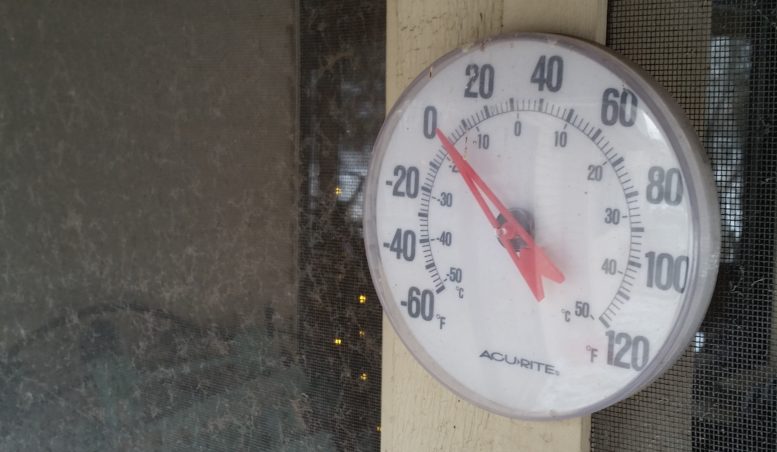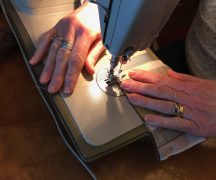By JAN LARSON McLAUGHLIN
BG Independent News
We might as well get used to it. The cold dipped down to minus 4 degrees early this morning, and temperatures aren’t expected to get to 20 or above for another week.
For some, the frigid temperatures are more than a cause for discomfort. The brittle cold can lead to burst pipes, frozen paws, frostbitten fingers and car problems.
Some professionals in Bowling Green accustomed to dealing with the complications of cold weather offered some advice on how to protect people, pets, pipes and vehicles during these frigid temperatures.
First, how people can prevent harm to themselves …
“I wouldn’t be out more than a half hour at a time,” said Kevin Hosley, registered nurse at Wood County Hospital Emergency Department. And bundle up. “Any exposed skin should be covered.”
People with lung problems or the elderly should avoid being out in this brittle cold, Hosley added.
The most serious risk to humans is hypothermia, when the body’s temperature drops dangerously low, said Alex Aspacher, community outreach coordinator with the Wood County Health District.
“Basically, your body starts to lose heat faster than it can replace it,” Aspacher said.
One symptom of hypothermia is confusion, so “somebody might not know they have it,” he added.
Hunters and homeless people are susceptible, but in these frigid temperatures some people are at risk even if they aren’t outside. Especially vulnerable are babies or older people in very cold homes. “Older people lose body heat faster” and babies aren’t able to generate heat the way others can to keep themselves warm, Aspacher said.
If hypothermia is suspected, the person’s temperature should be taken. If below 95 degrees, 911 should be called, he said. Any wet clothing should be removed, and the person should be placed in a warm room and bundled in blankets – an electric blanket if available.
The other risk with the cold is frostbite, when skin is exposed, commonly on the face, hands and feet. Aspacher explained that in frigid weather, the body prioritizes which areas to keep warm, so the extremities are likely to suffer first.
If frostbite is suspected, the area should be warmed with an electric blanket or warm water – not hot water, Aspacher cautioned. The frostbitten areas should not be massaged, and the person should avoid walking on frostbitten toes and feet.
The health district also advises that people should be prepared for power outages by having a three-day supply of water, canned food, medications and pet foods in their homes. A cold weather kit should also be stocked with duct tape, a weather radio and a wrench to shut off burst pipes.
Next, how to protect your pets …
House pets aren’t accustomed to any extended exposure to these type of temperatures, said Janet Duty, of the Animal Hospital at West Ridge in Bowling Green.
Some dogs get really excited about playing out in the snow – but people need to keep an eye on them.
“Indoor dogs are not as adaptable,” Duty said. “Watch for signs of them limping. Snow gets stuck between their toes” and the pads on their paws can be cut by ice.
Outdoor animals, such as barn cats, need to have places to cuddle up out of the wind. “Make sure they have a place that’s dry,” Duty said.
And water need to be frequently replaced, since it won’t take long in these temperatures for a bowl of water to become a block of ice. “Water needs to be maintained,” she said. “It will freeze solid.”
How to avoid problems at home …
Turning heat down too far at home won’t save money if the pipes freeze and burst. Just ask Neil Gearhart, of Gearhart Plumbing, Heating and Cooling in Bowling Green.
“It’s going to be a long night,” Gearhart said as he prepared to go out on another emergency call Wednesday night.
Gearhart’s crews have been working round the clock, responding to homes where water pipes have frozen and burst. Weather forecasts are predicting one of the longest “cold snaps” in many years.
Most of the problems could be avoided with basic common sense, Gearhart said.
“There’s a whole slew of millennials who don’t know what to do,” Gearhart said. It’s simple – don’t turn the heat way down in a house during this weather. Even thermostats that automatically turn down to 62 at night can be dangerous in this brittle cold, he said.
And keep cupboard doors open under sinks that are on the outside wall of a home, he said.
Gearhart said he often responds to homes where garage doors and home vents aren’t kept closed, even in this weather. “A little common sense would be nice,” he said.
It would also be helpful for homeowners to know how to turn the water off to their home – before they have to learn during an emergency.
Bowling Green sees a lot of burst pipes when weather like this hits during winter break. When student renters leave for the break, some turn off their heat, thinking it will save money. It’s not uncommon for local plumbers to get calls from police officers who notice the problems first.
“We get calls that water is pouring out of the front door and freezing,” Gearhart said.
Gearhart even remembers one incident when police noticed water coming out a second story window. The freezing water caused the siding to fall off as one frozen sheet, he said.
Some landlords don’t check the properties, so some renters will return to cold and wet homes. “As the college kids come back, they will find problems,” he said.
What about safety out on the road …
To be honest, many vehicle problems encountered in the winter cold could be avoided with check-ups in the fall, said Jay Sockman, of Sockman Automotive in Bowling Green.
The battery, wipers, washer fluid, antifreeze, and tires should be checked.
Drivers should pack an emergency kit for winter, which should be stocked with water, energy bars, jumper cables, flashlight, and a battery pack with a port to power cell phones. Some battery packs can even jumpstart cars, Sockman said.
It’s also a good idea to pack a bag of kitty litter, which serves a dual purpose of adding weight to the car and adding traction to icy surfaces.
When driving in these frigid temperatures, Sockman suggested giving a car time to warm up. “Let it run 10 minutes,” he said.
And don’t rely on the windshield wipers or electric windows to clean off the ice. Scrape off the windows and make sure they aren’t frozen, so the cables aren’t snapped or motors ruined trying to unstick the windows or wipers.
When traveling any great distance in this weather, get your vehicle checked out before you hit the road, Sockman said.
“If you’re planning on going somewhere, don’t wait to schedule your car in,” he said.





